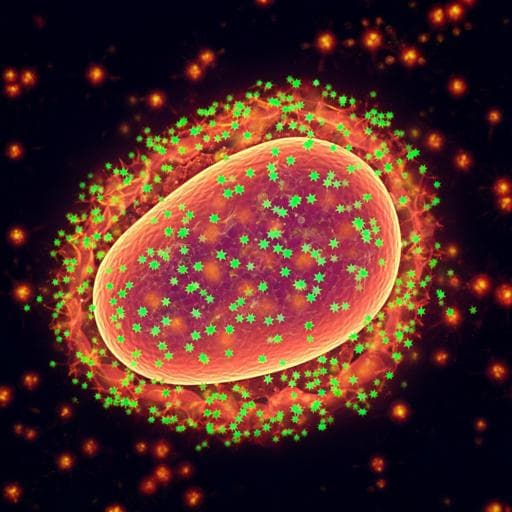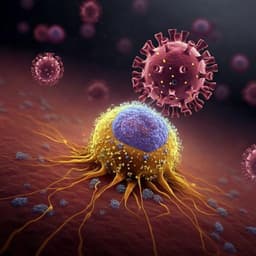
Medicine and Health
Hyperactive Natural Killer cells in Rag2 knockout mice inhibit the development of acute myeloid leukemia
E. Sugimoto, J. Li, et al.
This groundbreaking study unveils the pivotal role of hyperactive natural killer (NK) cells in combating acute myeloid leukemia (AML). Conducted by a team of researchers, it demonstrates how NK cells can significantly hinder AML progression, especially during tumor evolution. Discover the exciting implications of these findings!
~3 min • Beginner • English
Introduction
Acute myeloid leukemia (AML) is an aggressive hematologic malignancy characterized by uncontrolled proliferation of myeloid cells. Allogeneic hematopoietic stem cell transplantation (HSCT) remains the only curative therapy due largely to the graft-versus-leukemia (GVL) effect mediated by donor T cells. While multiple T cell–focused immunotherapies (e.g., CAR-T, BiTEs, checkpoint inhibitors) have transformed outcomes in several cancers, translation to AML has been limited. In parallel, innate immunity, particularly Natural Killer (NK) cells, contributes to tumor surveillance via recognition of altered or absent major histocompatibility complex class I (MHC-I) on target cells, enabling killing through “missing-self” mechanisms. Because MHC-I downregulation is a common route of evasion from T cell surveillance, NK cells may compensate to control AML. This study investigates how innate immunity—especially NK cells—influences AML development in Rag2−/− mice that lack adaptive lymphocytes but retain NK cells, and how tumor immunogenicity evolves under immune pressure.
Literature Review
The work builds on evidence that the GVL effect in HSCT is primarily T cell–mediated and that NK cells can contribute to antileukemia responses, including donor NK alloreactivity efficacy in mismatched transplants. Prior advances in T cell–based immunotherapies have had limited success in AML, underscoring a need to exploit innate immune mechanisms. MLL fusion–driven AML (e.g., MLL-AF9) and RUNX1-ETO9a AML are well-established murine models to study leukemogenesis and immune interactions. Previous reports highlighted NK cell roles in AML microenvironments and the therapeutic potential of p53 activation (e.g., MDM2 inhibition) augmented by antitumor immunity. This study integrates these strands to dissect NK versus adaptive immunity across genetically distinct myeloid leukemias.
Methodology
- Mouse strains and ethics: WT C57BL/6J, C57BL/6J-Rag2−/−, and NOD strains (including NSG) were used (8–12 weeks old). Animal protocols were approved by the University of Tokyo IACUC (PA15-100, PA18-46).
- AML and MDS/AML models: Murine bone marrow progenitors were retrovirally transduced with oncogenes to generate leukemia models: MLL-AF9 for AML; RUNX1-ETO9a for AML; combinations such as RUNX1 and ASXL1 mutant (rAM/cRAM) and SETBP1 plus ASXL1 mutant (cSAM) for MDS/AML. Primary transplants were into sublethally irradiated recipients, followed by serial transplants (including into non-irradiated recipients) to enrich leukemia-initiating activity and generate aggressive lines (e.g., MLL-AF9-2021 and MLL-AF9-2022).
- Pharmacologic intervention: The p53-MDM2 inhibitor DS-5272 was administered orally three times weekly for 2–3 weeks (dose per experiment per figure legend; e.g., methods note 10 mg/kg/day; Fig. 5 used 100 mg/kg).
- NK cell manipulation: NK cells were depleted in vivo using anti-NK1.1 (clone PK136, 200 µg i.p. weekly starting one week before transplantation). NK cells were identified by NK1.1 and other markers by flow cytometry and immunohistochemistry.
- CRISPR/Cas9 gene editing: To test missing-self effects, B2m was targeted in MLL-AF9 cells using Cas9 (lentiCas-Blast) with sgRNAs (e.g., B2m-sg1) cloned into pLKO5sgRNA-dRFP657 or lentiGuide-Puro. Transduced cells (RFP657+) were assayed in vitro (replating) and transplanted into WT, Rag2−/−, and NSG mice to evaluate leukemogenesis and selection dynamics.
- Flow cytometry and histology: Leukemia burden and NK phenotypes were quantified in PB, BM, and spleen using multicolor flow cytometry (e.g., H2-Kb for MHC-I, NK activation markers CD107a, CD69, Sca-1; apoptosis by Annexin V/DAPI). Bone marrow and spleen sections were immunostained with anti-NK1.1 for tissue localization.
- NK functional assays: Splenic NK cells (CD49b+CD3ε−) from WT or Rag2−/− mice were co-cultured with YAC-1 targets at varying effector:target ratios to assess cytotoxicity (Annexin V/DAPI in labeled targets) and degranulation (CD107a). For assays against sgRNA-edited MLL-AF9 cells, NK cells were pre-activated with IL-2/IL-15.
- RNA-seq: RNA from GFP+ AML cells harvested from WT, Rag2−/−, and NSG hosts was sequenced. Alignments (mm10) used HISAT2; differential expression used limma with FDR<0.05; enrichment by GSEA and GO/clusterProfiler. Datasets deposited (GEO GSE253485, GSE254359).
- Statistics: Group comparisons used two-tailed Student’s t test, Mann–Whitney, or ANOVA with appropriate post hoc tests. Survival was analyzed by log-rank tests. GraphPad Prism 9 was used; exact p-values in Supplementary Table 3.
Key Findings
- AML progression is slower in Rag2−/− mice than in immunocompetent WT C57BL/6 and is faster in highly immunodeficient NSG mice. Survival curves showed significant delays in disease in Rag2−/− recipients (log-rank p<0.05–0.01 depending on cohort). Leukemia engraftment (GFP+ burden in peripheral blood and spleen) was reduced in Rag2−/− mice.
- NK cells are increased and hyperactivated in Rag2−/− mice: numbers and frequencies of NK cells were higher in PB, BM, and spleen (p<0.01). NK cells exhibited higher activation markers (CD107a, CD69, Sca-1). In co-cultures, Rag2−/− NK cells displayed greater cytotoxicity than WT NK cells across effector:target ratios and higher degranulation: CD107a+ NK cells ~80% in Rag2−/− vs ~40% in WT (p<0.0001). IFNγ+ NK cells upon PMA/ionomycin stimulation were ~60% in Rag2−/− vs ~10% in WT (p<0.0001).
- Tumor-intrinsic transcriptomic changes in Rag2−/− hosts: AML cells from Rag2−/− mice showed distinct RNA-seq profiles with upregulation of inflammation/innate immunity genes, including enrichment of inflammatory response and IL-6–JAK–STAT3 pathways (GSEA). Surface MHC-I (H2-Kb) expression was higher on AML cells from Rag2−/− vs WT.
- Missing-self sensitization limits leukemia: CRISPR B2m loss (abrogating MHC-I) impaired in vivo growth of MLL-AF9 leukemia, consistent with enhanced NK surveillance. In mixed populations, B2m-deficient (RFP657+) AML cells were negatively selected in WT and Rag2−/− hosts, indicating NK-mediated elimination; selection was not observed in NSG mice.
- NK cell depletion abolishes protection: Depleting NK cells with anti-NK1.1 eliminated the survival advantage of Rag2−/− mice and accelerated AML progression (log-rank p<0.001), establishing NK cells as the dominant antileukemia effector in this context.
- Pharmacologic synergy with p53 activation: The MDM2 inhibitor DS-5272 produced stronger antileukemic effects in Rag2−/− mice than in WT, further prolonging survival and reducing circulating leukemia burden (e.g., RUNX1-ETO9a model, p<0.01).
- Model- and evolution-dependent immunogenicity: Delayed onset in Rag2−/− mice was observed in multiple models (e.g., MLL-AF9, RUNX1-ETO9a; and cRAM), whereas responses varied in cSAM models. Serial transplantation generated aggressive MLL-AF9-2022 cells that appeared more resistant to adaptive immunity yet remained susceptible to NK-mediated suppression in Rag2−/− hosts. Transcriptomic analyses indicated substantial remodeling between MLL-AF9-2021 and -2022 lines.
Discussion
The study demonstrates that, despite the absence of adaptive lymphocytes, Rag2−/− mice mount potent antileukemia responses through quantitatively increased and functionally hyperactive NK cells. The slower AML progression and reduced engraftment in Rag2−/− mice, together with the loss of this protection after NK depletion, directly implicate NK cells as key suppressors of AML. Upregulation of MHC-I and inflammatory programs in AML cells harvested from Rag2−/− hosts suggests tumor adaptation to innate immune pressure. Conversely, B2m deletion activates missing-self recognition and curtails leukemia growth in vivo, aligning with enhanced NK cytotoxicity observed ex vivo. The finding that DS-5272 efficacy is greater in Rag2−/− mice implies that therapies which activate tumor suppressor pathways (e.g., p53) can be potentiated by robust innate immune surveillance. Importantly, immunogenicity varies across oncogenic drivers and evolves with serial transplantation: aggressive AMLs may acquire resistance to adaptive immunity while retaining susceptibility to NK cell–mediated control. These insights underscore NK cells as a therapeutic axis in AML and highlight Rag2−/− mice as a model to study innate immune–tumor dynamics and drug–immunity interactions.
Conclusion
NK cells in Rag2−/− mice are numerically increased, highly activated, and functionally cytotoxic, conferring significant control over AML progression. Loss of MHC-I through B2m deletion sensitizes AML to NK-mediated elimination in vivo, whereas NK depletion reverses the protective phenotype. AML cells adapt transcriptionally to innate immune pressure, and tumor immunogenicity is model- and evolution-dependent. Pharmacologic p53 activation (DS-5272) exhibits enhanced antileukemic effects in the context of hyperactive NK immunity. Collectively, the study establishes NK cells as dominant innate effectors against certain AML subtypes and suggests leveraging NK activity—alone or combined with p53 activation—as a therapeutic strategy. Future work should dissect the NK receptor–ligand interactions governing AML recognition, define biomarkers of NK susceptibility across genetic subtypes, and evaluate combination regimens that co-optimize tumor-intrinsic stress pathways and NK effector function.
Limitations
- Murine models may not fully recapitulate human AML immunobiology; Rag2−/− mice have unique NK phenotypes that may not translate directly to patients.
- Results are model-dependent (MLL-AF9, RUNX1-ETO9a, cRAM, cSAM) and may not generalize across all AML genotypes or disease stages.
- NK depletion by anti-NK1.1 may have off-target effects on related ILC populations; residual NK activity cannot be fully excluded.
- Dosing regimens for DS-5272 differed across experiments (e.g., 10 mg/kg vs 100 mg/kg in figure legend), which could influence comparative interpretations.
- Sample sizes were modest in some assays, and some figure details were limited to representative experiments; formal power calculations were not performed.
Related Publications
Explore these studies to deepen your understanding of the subject.







